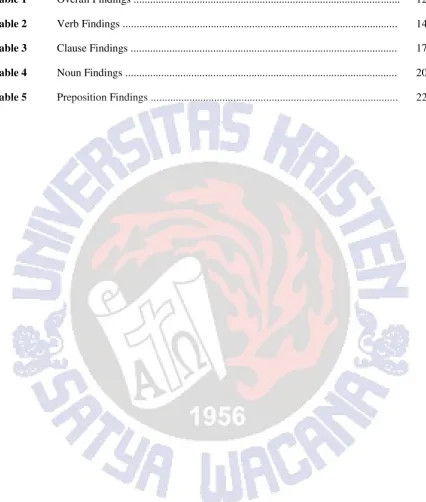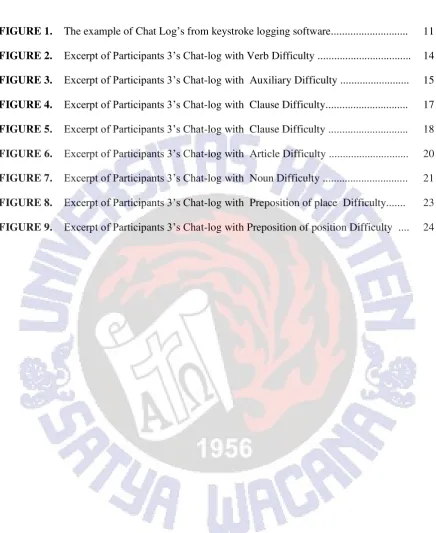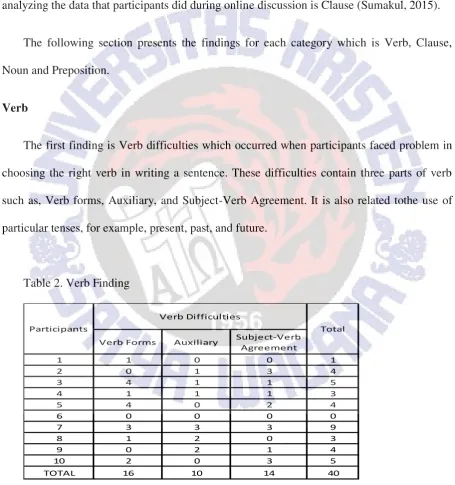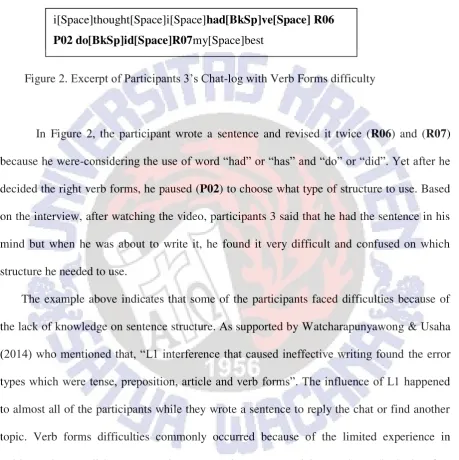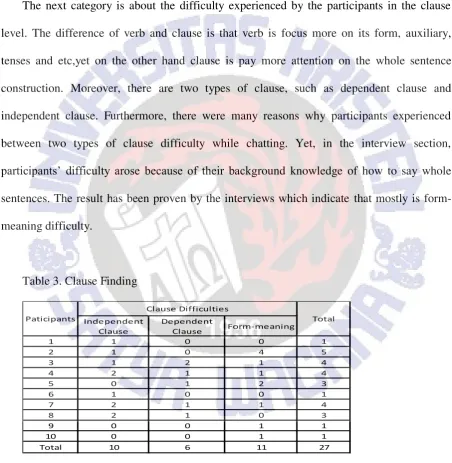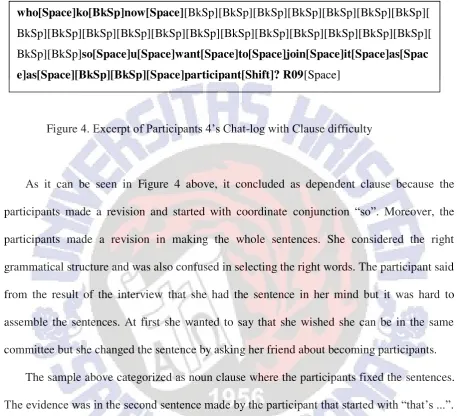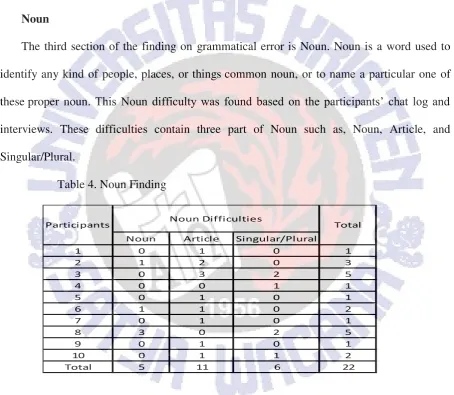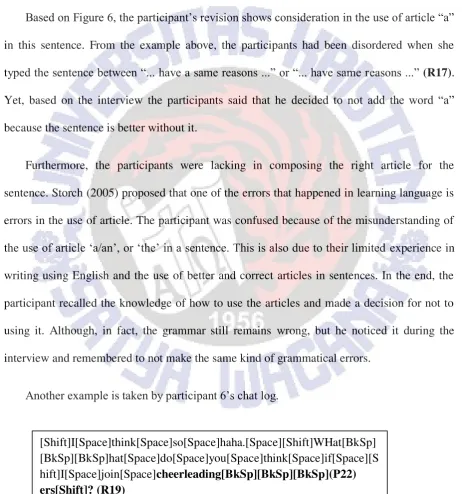GRAMMAR DIFFICULTIES FACED BY FLA UKSW FIRST YEAR STUDENTS’ DURING ONLINE DISCUSSION
THESIS
Submitted in Partial Fulfillment Of the Requirement for the Degree of
Sarjana Pendidikan
Amanda Natasya 112014015
ENGLISH LANGUAGE EDUCATION PROGRAM FACULTY OF LANGUAGE AND ARTS UNIVERSITAS KRISTEN SATYA WACANA
ii
GRAMMAR DIFFICULTIES FACED BY FLA UKSW FIRST YEAR STUDENTS’ DURING ONLINE DISCUSSION
THESIS
Submitted in Partial Fulfillment Of the Requirement for the Degree of
Sarjana Pendidikan
Amanda Natasya 112014015
ENGLISH LANGUAGE EDUCATION PROGRAM FACULTY OF LANGUAGE AND ARTS UNIVERSITAS KRISTEN SATYA WACANA
vi
COPYRIGHT STATEMENT
This thesis contains no such material as has been submitted for examination in any course or accepted for the fulfillment of any degree or diploma in any university. To the best of my knowledge and my belief, this contains no material previously published or written by any other person except where due reference is made in the text.
Copyright@ 2018. Amanda Natasya and Dian Toar Y.G Sumakul, M.A
All rights reserved. No part of this thesis may be reproduced by any means without the permission of at least one of the copyright owners or the English Language Education Program, Faculty of Language and Arts, Universitas Kristen Satya Wacana, Salatiga.
viii TABLE OF CONTENTS
Cover Page ... i
Inside Cover Page ... ii
Pernyataan Tidak Plagiat ... iii
Pernyataan Persetujuan Akses ... iv
Publication Agreement Declaration ... v
Copyright Statement ... vi
Grammatical errors in CMC through online discussion ... 7
ix
LIST OF TABLE
Table 1 Overall Findings ... 12
Table 2 Verb Findings ... 14
Table 3 Clause Findings ... 17
Table 4 Noun Findings ... 20
x
LIST OF FIGURES
FIGURE 1. The example of Chat Log‟s from keystroke logging software... 11
FIGURE 2. Excerpt of Participants 3‟s Chat-log with Verb Difficulty ... 14
FIGURE 3. Excerpt of Participants 3‟s Chat-log with Auxiliary Difficulty ... 15
FIGURE 4. Excerpt of Participants 3‟s Chat-log with Clause Difficulty... 17
FIGURE 5. Excerpt of Participants 3‟s Chat-log with Clause Difficulty ... 18
FIGURE 6. Excerpt of Participants 3‟s Chat-log with Article Difficulty ... 20
FIGURE 7. Excerpt of Participants 3‟s Chat-log with Noun Difficulty ... 21
FIGURE 8. Excerpt of Participants 3‟s Chat-log with Preposition of place Difficulty... 23
1
GRAMMAR DIFFICULTIES FACED BY FLA UKSW FIRST YEAR STUDENTS’ DURING ONLINE DISCUSSION
Amanda Natasya
Abstract
The rapid development of technology has brought up a new mode of communication, computer mediated communication. This form of communication is also common in teaching and learning activities in EFL context, where students are engage in online discussions. As in face-to-face communication, however, students also experience language difficulties in online discussions. This study wanted to investigate the grammatical difficulties faced by EFL learners during online discussions. The participants of this research were 10 participants from first year student in FLA UKSW. Moreover, this research used SRP (Stimulated Recall Protocol) to know what happen in their mind while doing pauses or revisions. The data of this research was taken using screen recorder in the form of video and chat log. The data was analyzed by using keylogger in the form chat log and interview result. This research found 4 top of grammar difficulties, which are Verb, Clause, Noun, and Preposition.
Keywords: CMC, Grammar, the effect of L1, pause and revision
INTRODUCTION
Communication by means of internet is commonly used in today‟s teaching and learning
2
the benefits in using online discussion is that it can become a tool for checking students‟
problem(s) especially in grammar. The study of Barkaoui, 2010b; Huang & Foote, 2010; Sweedler-Brown, 1993 (as cited in Neumann 2014) in English as a Foreign Language or EFL, stated that mistakes are a normal incident made by students because their L1 is still affecting their L2 acquisition. Moreover, it would force difficulties toward the students in deciding the correct grammar in writing. However, types of grammar difficulties can be known by using CMC as the media to aid students in realizing their grammar mistakes.
Furthermore, Savas (2011) examined that CMC can be used to deliberate what linguistic variation are used while chatting online. In the study, the participants are Native Speaker (NS) and Non Native Speaker (NNS). The results of this research which were attended by both participants resulted in equal communication skills although there were limitless error due to grammar, spelling and punctuation. Moreover, the problems that were faced by the participants seemed to be tolerated since the participants used correct vocabulary and simple structure. In addition, grammatical errors tend to happen in the learners who are studying English as a Foreign Language (EFL). One of the grammatical errors frequently created by students is that they do not realize the need of verb change when the form of the subject is different. In another study, Suthiwartnarueput (2012) analyzed writing problems caused by student‟s L1. The participants were English major in Thailand that was asked to write in
English. The study resulted with five most frequent errors made by the students, such as verb tense, word choice, sentence structure, preposition, and modal auxiliary.
3
4 same time, such as text and video chat. In synchronous, the communication happens in real time where people are able to think and edit what are they going to say before sending it (Sumakul,2015). Asynchronous CMC, however, is a type that refers to where a conversation does not depend on an immediate answer for example email, text message, online discussion, etc. (Adams, Alwi, & Newton, 2015).
Additionally, CMC can be a tool for communication to make communication opportunities easily happen. As mentioned by Sumakul (2015), there are problems that EFL learners faced during the communication, like Face-to-Face (FTF) speaking or conversation in CMC. Additionally, CMC could be an aid to bridge the process of communication between oral and written for some of students to for them to have complete advantage from learning language as mentioned in Beauvois‟ study (as cited in Savas, 2011). It could help them
respectively to strengthen their grammar in learning a language. As stated in Sherblom, et al., (2013) Computer Mediated Communication (CMC) could be a tool to develop the skills by increasing the knowledge of the students. Furthermore, because knowledge and skill are connected with each other, and the participants‟ attentiveness and expressiveness has been
5
aids in developing the skill and knowledge of language learning, especially in writing skill whether it was used using the right grammar.
Moreover, CMC, specifically the synchronous type (e.g text and video chat) is mostly used to investigate what kind of language problem that occurs in written and oral skill. CMC can be a method in language learning and practice. Blake 2007; Chapelle, 2004 studies (as cited in Adams, Alwi, & Newton, 2015) stated that CMC can help learner increase their skill in writing and speaking. Additionally, misuse of grammar rule while texting is connected with specific grammatical errors that also came up when using written or oral language (Wood, Kemp, Waldron, & Hart, 2014). CMC, especially the synchronous type has been able to be communicated using emotion through writing as good as speaking. In practicing language learning, mistakes might occur during the ongoing communication. The problems that usually happen in communication are incomplete sentences, repeating, and the use of everyday language. By using CMC as a tool of communication and learning, learners can be more aware with the language they use, especially in grammar.
Grammar
6
something (de Smet, Gruwel, Leijten, & Kirschner, 2014). Studying English as ESL or EFL are faced with many problems in producing the language. Furthermore, Slinkker‟s study (as
cited in Wu & Gaza, 2014) found that EFL learners will face at least a problem because their mother tongue will impact how they transfer language form from the mother tongue into other language.
Furthermore, in language learning, the learners will not only learn about English, but also produce something such as oral and written reports. As stated in the journal, writing can be one individual learning activity where students will be able to recognize their mistakes in written form (Hodges, 2002). There are problems in writing, such as spelling, grammar, punctuation and the linguistic expression that is made by EFL learners as mentioned in Matsuhashi & Gordon (as cited in Stevenson, M et al., 2006). There are requirements to produce text in L1 and FL/L2 writing models like content, form, and process. In both L1 and FL/L2, there is a necessary component in language knowledge that is grammatical knowledge as language testing literature (Bachmman, 1990; Bachman & Palmer, 1996; Weigle, 2002 studies,as cited in Neumann, 2014). Therefore, student‟s knowledge of grammar makes them have fewer mistakes in writing. Moreover, there would be lack of language mastery therefore the learners are used to making revision to their writing (Stevenson, M et al., 2006).
7
grammatical and lexical knowledge. In addition, Huang‟s (2001) research (as cited in Wu &
Garza, 2014) stated that there are grammatical errors made and the top six common errors made are verb, noun, spelling, article, preposition and word choice.
Grammatical errors in CMC through online discussion
Sumakul (2015), investigated EFL Learners‟ Grammatical Difficulties during CMC interaction. The aim of this study was to find grammatical difficulties experienced by EFL students‟ during Computer-Mediated Communication (CMC). They were asked to do online
chatting and the process was observed and recorded. The result of this research, Sumakul writes, was that CMC through online chatting can help in knowing what grammar errors are commonly made by students. There are 8 grammar errors that EFL students did such as, verb forms, clauses, auxiliaries, noun, preposition, determiners, collocation, and direct indirect objective. This happens because there is a big distinction between English and Indonesian verbs.
8
Concluding the two previous studies, Sumakul‟s (2015) and Wood, Kemp, Waldron, & Hart (2014) above on the use of CMC for the same type of CMC that is synchronous can be used in different methods. In one, the study that uses online discussion and the other one uses text messaging as the teaching method. Furthermore, there was a grammatical error from students that are both the same that is most students who are writing make errors on changing the verb and choosing the right grammar. In addition, one of the previous studies focuses on what happened to the students‟ mind while they are in online discussion. The other one
focuses on what grammar mistake are produced during the text messaging. Both of these studies are the same in using CMC as a tool to know what grammar difficulties encountered by learners in writing. It also mentioned from the studies that CMC could be a device for students to not only analyze the result regarding grammar difficulties, but also help them recognize the mistake(s) they make in writing. It proves that technology can be one of the methods to increase students‟ willingness in learning language because there are some
9
THE STUDY
Research Question
According to the previous discussion, this a research question: What are grammar difficulties faced by FLA first year students in doing online discussion?
Context
This research used descriptive study which intended to find out students‟ problems in grammar while they were doing online discussion. It took place in the Faculty of Language and Arts of Universitas Kristen SatyaWacana, involving the first year students who were taking English Education Program. These students in Faculty of Language and Arts are used to online discussion through social media, email, Schoology, etc.
Participants
10 Instruments of data collection
This research was conducted using the Stimulate Recall Protocol (SRP). This method is to help participants materialize their thoughts that have been expressed by direct communication. By using SRP, participants were helped to remember what processes that happened in their thoughts and it was recorded in the form of a video. The video of the data was taken by using desktop screen recorder. The video was used to stimulate the mental processes during the communication. Furthermore, interviews were done as a recall step to understand what happened in the mental process that has been done (Jimenez, 2007). There is a deeper understanding of the participants‟ thinking process in their use of these strategies by using SRP (Jimenez, 2007). Moreover, Wenyu and Yang found what strategies can be approached by using SRP from the students by the use of subjects, pausing length and frequency of pauses (Wenyu & Yang, 2008).
Data collection procedure
11 Data analysis procedure
Data analysis was taken from the result of the recording and interviews. The result had many problem possibilities faced by the students during the online discussion, for example vocabulary and grammatical errors. The interview was used to find what students had in mind while they were doing the discussion.
Figure 1. The example of Chat Log‟s from keystroke logging software
Figure 1 is one of the examples of the result of the recording used keystroke logging software (Actual Keylogger) where the data was analyzed after their discussion session. The result of the analysis was to find the answer of the research question on grammar difficulties that the students made.
[Shift]Hi,[Space][Shift]Bim.[Space][Shift]How[Space]are[Space]you [Shift]?[Space][Shift][Shift]Long[Space]time[Space]no[Space]see[Sp ace]you.
12
FINDINGS AND DISCUSSION
This following part presents the findings and discussion of the study which provides the answer of the research question. The research showed descriptive findings based on grammatical errors students did in writing from the journal of Huang (2001) (as cited in Wu & Garza, 2014). The result of this study shows 4 majors‟ grammar difficulties from 10
participants based on the data collection, along with 98 circumstances. The 4 majors‟ grammar difficulties that will be discussed in this section are Verbs, Nouns, Prepositions and Clauses. From the table below, it can be seen that the highest number of errors made by
13
with only 6% which was made by one or two students, caused by confusion in choosing the right preposition during sentence arrangement. As the result from the table above,, it can be seen that three out of four are components that derived from Huang (2001) (as cited Wu & Garza, 2014) which is Verb, Noun and Preposition. Besides that, based on the study about grammar difficulties during CMC interaction,one grammar difficulty that was found after analyzing the data that participants did during online discussion is Clause (Sumakul, 2015).
The following section presents the findings for each category which is Verb, Clause, Noun and Preposition.
Verb
The first finding is Verb difficulties which occurred when participants faced problem in choosing the right verb in writing a sentence. These difficulties contain three parts of verb such as, Verb forms, Auxiliary, and Subject-Verb Agreement. It is also related tothe use of particular tenses, for example, present, past, and future.
14
There were 40 occurrences related to grammar difficulties especially in using Verb. It has been experienced by 3‟s participant in their grammatical errors. For the example, the
grammar difficulties related to Verb Forms in Figure 2 below from participants 3‟s Chat-log.
Figure 2. Excerpt of Participants 3‟s Chat-log with Verb Forms difficulty
In Figure 2, the participant wrote a sentence and revised it twice (R06) and (R07) because he were-considering the use of word “had” or “has” and “do” or “did”. Yet after he decided the right verb forms, he paused (P02) to choose what type of structure to use. Based on the interview, after watching the video, participants 3 said that he had the sentence in his mind but when he was about to write it, he found it very difficult and confused on which structure he needed to use.
The example above indicates that some of the participants faced difficulties because of the lack of knowledge on sentence structure. As supported by Watcharapunyawong & Usaha (2014) who mentioned that, “L1 interference that caused ineffective writing found the error types which were tense, preposition, article and verb forms”. The influence of L1 happened
to almost all of the participants while they wrote a sentence to reply the chat or find another topic. Verb forms difficulties commonly occurred because of the limited experience in writing using English context. There were also some participants that only had a few mistakes in using the verb forms because they were accustomed in using English as mentioned in the interview.
15
Another example is taken from participant 7‟s chat log.
Figure 3. Excerpt of Participants 7‟s Chat-log with Auxiliary difficulty
Figure 3 show that the participants made a mistake in deciding the right use of auxiliary. As the participant mention in the interview that she wanted write “I don‟t read the instruction carefully” but she also wanted to add the word “should”. It shows that the participants made a revision (R05) when he wrote the right auxiliary “I don‟t ...”, and changed it into “I should‟ve ...”.The sentence she wrote had the same meaning which is the
feeling of carelessness for not paying attention to the instruction that shown by the participants but also feeling regret.
Moreover, the example above showed that participants had difficulties in choosing the right Auxiliary. The results of the interview also support this kind of mistake that is made by the participant. As supported by Adams et al., (2015) learners who study the language pay attention in prioritizing accuracy, especially on two linguistic forms (auxiliary and modal verbs) rather than on the syntax or lexical. The table above showed 6 out of 10 misused the auxiliary in writing therefore it can be signified as a rare mistake. It can be seen from the table above there were a few participants who misunderstood auxiliary compared to other verb forms errors.
As mentioned before, there are three types of verb mistakes, such as auxiliary, subject-verb agreement and “verb forms” which are developed to be the most errors made by the participants. On top of that, most of the participants said in the interview that it was very
16
difficult for them to choose the correct tenses to use while chatting at the same time. However, some participants declared that it was not too difficult for them to pick the right tenses because they had their grammar course from the first semester.
Clause
The next category is about the difficulty experienced by the participants in the clause level. The difference of verb and clause is that verb is focus more on its form, auxiliary, tenses and etc,yet on the other hand clause is pay more attention on the whole sentence construction. Moreover, there are two types of clause, such as dependent clause and independent clause. Furthermore, there were many reasons why participants experienced between two types of clause difficulty while chatting. Yet, in the interview section, participants‟ difficulty arose because of their background knowledge of how to say whole
sentences. The result has been proven by the interviews which indicate that mostly is form-meaning difficulty.
17
grammar difficulties related to Clause is shown in Figure 4 below from participants 5‟s Chat
-log.
Figure 4. Excerpt of Participants 4‟s Chat-log with Clause difficulty
As it can be seen in Figure 4 above, it concluded as dependent clause because the participants made a revision and started with coordinate conjunction “so”. Moreover, the participants made a revision in making the whole sentences. She considered the right grammatical structure and was also confused in selecting the right words. The participant said from the result of the interview that she had the sentence in her mind but it was hard to assemble the sentences. At first she wanted to say that she wished she can be in the same committee but she changed the sentence by asking her friend about becoming participants.
The sample above categorized as noun clause where the participants fixed the sentences. The evidence was in the second sentence made by the participant that started with “that‟s ...”.
It has been verified by Foster et al (2002) that a dependent clause is a limited or non-limited clause and frequently additional clauses, where it involves subject, object, and adverbial. It concluded as dependent clause, especially noun clause, is commonly used to make the sentence simpler. Although dependent clause can or cannot stand alone, it is proven by the participant that dependent have no limitation and can stand alone.
18
Additional example is taken by participant 7‟s chat log.
Figure 5. Excerpt of Participants 7‟s Chat-log with another Clause difficulty
Figure 5, shows the chat log of participant 7‟s conversation. The prefix of word
“that‟s ...” in the sentence from chat log‟s above it was the example of independent clause as
proved above by participant after changed it. It has been identified from the interview that participants build up mistakes in choosing the right sentences. It is shown by the participant‟s
explanation from the interview, where at first she wanted to say that her score was bad, but also wanted to say the reason why. Yet, she erased the sentence and changed it into an agreeably the statement that she did not pay attention to the instruction.
The chat‟s log example was one of the problems from many problems of clause in writing. As mentioned by Faigley, L and Witte, S (cited in Stevenson, M et al., 2006), a writer could add or make revisions to the text, substitute word or sentences, change the clause, or remake clause with different structure (syntax), (e.g from two clauses become one clause or in the other way). Participant stated that she confused what should be written to explain for more pay attention to the instruction. It is proven by the participants from the interview that the problem also occurred here, it came back to how often people use English in daily life.
19
Clause problem occurred by their limitation in making the correct sentence and changing the sentence from their L1 into English. Yet several participants said that when they wanted to write the sentence, they had the sentence in their mind already. Although it is in the form of
20
Figure 6. Excerpt of Participants 3‟s Chat-log with Article difficulty
Based on Figure 6, the participant‟s revision shows consideration in the use of article “a”
in this sentence. From the example above, the participants had been disordered when she typed the sentence between “... have a same reasons ...” or “... have same reasons ...” (R17). Yet, based on the interview the participants said that he decided to not add the word “a” because the sentence is better without it.
Furthermore, the participants were lacking in composing the right article for the sentence. Storch (2005) proposed that one of the errors that happened in learning language is errors in the use of article. The participant was confused because of the misunderstanding of the use of article „a/an‟, or „the‟ in a sentence. This is also due to their limited experience in
writing using English and the use of better and correct articles in sentences. In the end, the participant recalled the knowledge of how to use the articles and made a decision for not to using it. Although, in fact, the grammar still remains wrong, but he noticed it during the interview and remembered to not make the same kind of grammatical errors.
Another example is taken by participant 6‟s chat log.
21
As shown in Figure 7, misinterpretation of Noun was made by the participant in common noun identification. As it can be seen that the “pause” shows the participants thought in determining the word “cheerleading” or “cheerleaders” (P22) that she wrote before. It has been identified from the interview that participant changed it into cheerleader because of she used to hear the word. Yet, the participants paused and revised when trying to pick the right word in the chatting section. The participants accidentally made the mistake because it has the same meaning of that kind of activity.
In addition, the Noun problem occurs only a few times and not all participants made the mistake. This is in line with Laiacona & Caramazza (cited in Rapp & Caramazza, 2002) who wrote that verb errors happened more often in speaking but less nouns errors in writing. The chat log from participant above is one example of noun error usage in writing. It is strengthened by the interviewed result from the participant who exclaimed that she rather chose cheerleaders due to the experience of hearing the word more often than cheerleading.
To complete this section, there are three kinds of mistakes that participants made during online discussion, such as noun, article and singular/plural. The most mistakes that were made in the Noun category were article. As stated by one of the participants during the interview, the use of “article” is fairly simple yet they are still confused when to decide whether the objects are general things or place or a place that they often visit. A problem arises in the use of noun; their absence in using it has a big influence in choosing whether the word is a noun or a verb.
Preposition
Last but not least, the minor grammar difficulty that was faced by the participant was Preposition. Preposition, as Hornby (1995) in the dictionary entitled Oxford Advance
22 has been made by 2 participants in their grammatical errors. Example related to Preposition mistake is shown in Figure 8 below of participants 2‟s Chat-log.
Figure 8. Excerpt of Participants 2‟s Chat-log with Preposition of place difficulty
Figure 8 shows a preposition problem which is “want to tell about describing place”. As the participant explain during the interview that she made a mistake while writing the sentence because of disordered in her mind with what she would talked about. It is shown from the participant‟s chat log above, that she is re-making the sentence by deleting the word “in” from the sentence. At first the participant said from the interview result she wanted to ask the opinion “about the participants in Flasco”, and then she deleted the preposition and
about[Space]the[Space]participants[Space]in[Space][BkSp][BkSp][B kSp][BkSp], (R23)
23
reformed it. The participants continued the sentence by asking about the supporter and the achievement.
The preposition mistake rarely occurs in the writing section. The example above can be seen as one of the problem that participants made while writing a sentence. It is mentioned in Storch (2005) that one of the errors that happened in learning language is not errors in use of articles but also errors in use of prepositions. Although it rarely happens but it is likely to happen because of accidental mistake when writing something. As it can be seen from the chat log above, the participants suddenly change and adding another kind of activity within the event they joined.
Another example is taken from participant 9‟s chat log.
Figure 9. Excerpt of Participants 9‟s Chat-log with Preposition of position mistake
In Figure 9, the preposition mistake is about the position. Here, the participant wanted to explain what division she got in the event. As it can be seen above, the participant wanted to use the preposition “on” and fixed it into “in”. Based on the interview, the participant
revised the preposition because “in” is more suitable in explaining the position of the division
that she got.
The participant‟s chat log above is about deciding the right preposition. It has been stated in Tetreault & Chodorow (2008) that the most common preposition error that learners used incorrectly was “in”. The example above is about substitution of prepositions which is a
common problem in the use of prepositions and this can be seen from the use of a confusing [Shift]anyway,[Space][Shift]I'm[Space]o[BkSp]in[Space](R09)
24
and arbitrary usage of English preposition as written by Cronnel (1985). It strengthened by the interview that she forgot about the knowledge of the preposition in English.
25
CONCLUSION
The purpose of this study was to be familiar with grammar difficulties which are commonly faced by the first year students. This study was conducted by using 10 participants from FLA UKSW who were asked to do online discussion. Moreover, SRP was used to understand why they paused and revised their messages during online discussion. The online discussion was recorded in the form of video that could stimulate their grammar difficulties from the video. Then, the participants were not only asked to watch their own video but also to be interviewed to find out why they ‘paused’ and/or the ‘revised’ during the online discussion. In this case, the data was analyzed by using keylogger in the form of chat log. In result, there were many grammar difficulties found throughout this research.
Based on this study, there are four top grammar mistakes found, such as Verb, Clause, Noun and Preposition. Furthermore, the most grammar difficulties occurred when their L1 is affecting their L2, which in this case L2 is English language. Yet, almost all the participants declared that they have had the sentence(s) ready in mind but they were confused of how to write them down in English. Where most of the times; the grammatical error(s) were often influenced because the participantswerenot accustomed to the use of the grammar rulesand the form-meaning from bahasa Indonesia to English as stated by almost all the participants in the interviewed section. The participants also said from the result of the interview that they were more concerned about the grammar during the online discussion, that it made them did the revisions more frequently. The pedagogical implication of this finding may become a useful suggestion for the teachers, lecturers and other related parties to improve the students‟
26
but not least using different colors of board marker to deliver important explanation for student to understand more about grammar.
27
ACKNOWLEDGEMENT
28
REFERENCES
Adams, R, Alwi, Nik A. N. M, and Newton, J. (2015). Task Complexity Effects on The Complexity and accuracy of Writing Via Text Chat. Journal of Second LAnguage Writing, 64-81.
Adams, R., Alwi, N. A., & Newton, J. (2015). Task Complexity Effect on The Complexity and Accuracy of Writing Via Text Chat. Jourmal of Second Language Writing, 64-81. Bekele, T. A. (2010). Motivation and Satisfication in Internet-Supported Learning
Environment: A Review. Educational Technology & Society, 116-127. Cilliers, C. B. (2012). Student Perception of Academic Writing Skills Activities in A
Traditional Programming Course. Computers & Education, 1028-1024.
Commander, N. E., Zhao, Y., Gallagher, P. A., & You, Y. (2012). Promoting cross-cultural understanding of education through online discussions. Social and Behavioral Science, 4632-4642.
de Smet, M., Gruwel, S., Leijten, M., & Kirschner, P. (2014). Electronic outlining as a writing strategy: Effects on Students' Writing Products, Mental Effort, and Writing Process. Computers & Education, 352-366.
Doolan, S. (2017). Comparing Patterns of Error in Generation 1.5, L1, and L2 First-Year Composition Writing. Journal of Second Language Writing, 1-17.
Doolan, S., & Miller, D. (2012). Generation 1.5 written error patterns: A comparative study.
Journal of Second Language Writing, 1-22.
Fadda, H. A. (2012). Difficulties in Academic Writing: From the Perspective of King Saud University Post Graduate Students. English Language Teaching, 1-8.
Ferris, D. (1999). The Case for Grammar Correction in L2 Writing Classes: A Response to Truscott (1996). Journal of Secong Language Writing, 1-11.
Ferris, D. R. (2004). The "Grammar Correction" Debate in L2 Writing: Where are we, and where do we go from here? (and what do we do in the meantime ...?). Journal of Second Language Writing, 49-62.
Hartnett, M. (2016). Motivation in Online. Singapore: Springer Nature.
Hill, J., Ford, W. R., & Farreras, I. G. (2015). Real Coversation with Artificial Intellegence: A Comparison Between Human-Human Online Conversation and Human-Chatbot Conversations. Computers in Human Behaviour, 245-250.
Jimenez, A. F. (2007). Stimulated Recall Methodology in Language Atrrition Research.
29
Kaplan, R. B. (2005). Editing Contributed Scholarly Articles from A Language Management Perspective. Journal of Second Language Writing, 47-62.
Laiacona, M. &. (2010). The Noun/Verb Dissociation in Language Production: Varieties of Causes. Cognitive Neuropsychology.
Langum, V., & Sullivan, K. P. (2016). Writing Academic English as a Doctoral Student in Sweden: narrative perspective. Journal of Second Language Writing, 20-25.
Limbu, L., & Markaukaite, L. (2015). How Do Learners Experience Join Writing: University Students's Conception of Online Collaborative Writing Task and Environment.
Computer & Education, 1-64.
Miller, K., & Sullivan, K. P. (2006). Keystroke Logging: An Introduction. Dalam K. P. Sullivan, & E. Lindgren, Computer Keystroke Logging and Writing: Methods and Applications (hal. 1-10). Netherlands: Elsevier‟s Science & Technology.
Myhil, D. (2012). Grammar For Writing? An Investigation Of The Effect Of Contextualised Grammar Teaching On Students' Writing. 1-26.
Myhil, D. (2012). Grammar For Writing? An Investigation Of The Effect Of Contextualized Grammar Teaching On Students' Writing. 1-26.
Myhill, D., & Watson, A. (2013). The Role of Grammar in The Writing Curriculum: A Review of The Literature. Child Language Teaching and Therapy, 41-62. Negretti, R., & Kuuteeva, M. (2011). Fostering Metacognitive Genre Awareness in L2
Academic Reading and Wiriting: A Case Study of Pre-service English Teachers.
Journal of Second Language Writing, 95-110.
Neumann, H. (2014). Teacher Assessment of Grammatical Ability in Second Language Academic Writing: A Case Study. Journal of Second Language Writing, 83-107. Romero, C., Lopez, M. I., Luna, J. M., & Ventura, S. (2013). Predicting Students' Final
Performance from Participation in On-line Discussions Forums. Computer & Discussion, 458-472.
Savas, P. (2011). A Case Study of Contextual and Individual Factors that Shape Lingusitic Variation in Synchronous Text-based Computer-Mediated Communication. Journal of Pragmatics, 298-313.
Shaw, R. S. (2012). A Study of The Relationship Among Learning Styles, Participation Types, and Performance Programming Language Learning Supported by Online Forums. Computers & Education, 111-120.
Sherblom, J. C, Withers, L. A, & Leonard, L. G. (2013). The Influence of
30
Stevenson, M, Schoomep, R & Glooper, K. (2006). Revising in Two Languages: A Multi-dimensional Comparison of Online Writing Revisions in L1 and FL. Journal of Second Language Writing, 201-233.
Sumakul, D. T. (2013). Facebook Group in An EFL Grammar Classroom. 69-75.
Sumakul, D. T. (2015). EFL Learners' Grammartical Difficulties during CMC interaction. 1-16.
Sumakul, D. T. (2015). EFL Learners's Grammatical Difficulties during CMC interaction. 104-116.
Tafazoli, D., Nosratzadeh, H., & Hosseini, N. (2014). Computer-mediated corrective feedback in ESP courses: Reducing grammatical errors via Email. Social and Behavioral Sciences, 355-359.
Tetreault, J. R. (2008). The Ups and Downs of Preposition error Detection in ESL Writing. 865-872.
Watcharapunyawong, S. & Usaha, S (2013). Thai EFL Students' Writing Errors in Different Text Types: The Interference of The First Language. English Language Teaching. Wenyu, L., & Yang, L. (2008). Research in EFL Writing Strategy Using SRP: An Empirical
Study in DUT . Asian EFL Journal, 54-62, 68-70.
Wood, C, Kemp, N, Waldron, S & Hart, L. (2014). Grammatical Understanding, Literacy and Text Messaging in School Children and Undergraduate Students: A Concurrent Analysis. Computers & Education, 281-290.
Wu, H.-p., & Garza, E. (2014). Types and Attributes of English Writing Errors in the EFL Context - A Study of Error Analysis. Journal of Language Teaching and Research, 1256-1262.
